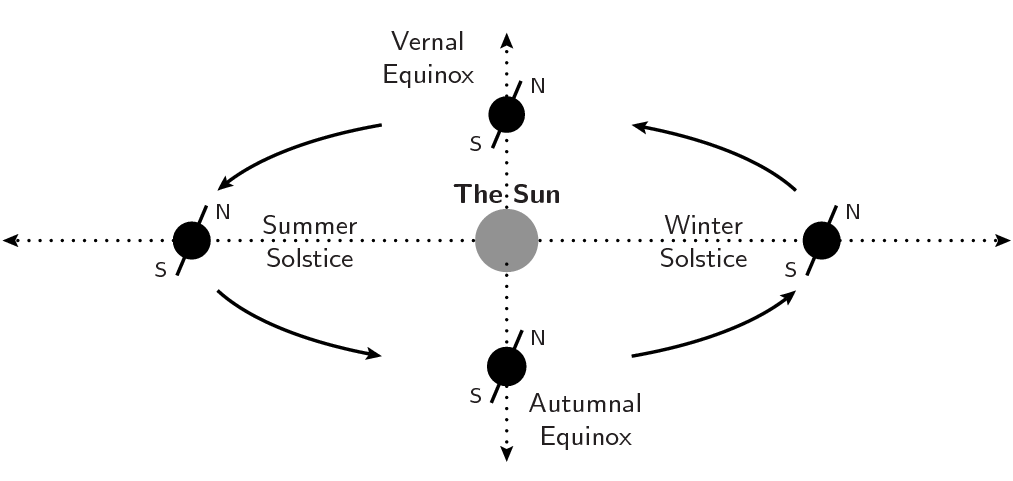The September equinox marks the first day of autumn for anybody living in the northern hemisphere, and the first day of spring for anybody living in the southern hemisphere.
On the day of the equinox, everywhere on Earth has almost exactly 12 hours of day and night, as the Sun's annual journey through the constellations of the zodiac carries it across the celestial equator. The word equinox is derived from the Latin words aequus (equal) and nox (night)
Wherever you live on Earth, on the day of the equinox the Sun will rise from the point on the horizon which lies due east, and set beneath the point which lies due west.
Equinox geometry
Equinoxes occur because the axis of the Earth's spin – its polar axis – is tilted at an angle of 23.5° to the plane of its orbit around the Sun.
The direction of the Earth's spin axis remains fixed in space as it circles around the Sun, while the Earth's sight line to the Sun moves through the constellations of the zodiac. As a result, sometimes the Earth's north pole is tilted towards the Sun (in June), and sometimes it is tilted away from it (in December). This gives rise to the Earth's seasons:

At the intermediate points between the solstices, the Sun lies directly over the Earth's equator on around 21 March and 23 September. In March, the Sun is travelling northwards across the equator, and in September it is travelling southwards.
The date of the equinox
| Year | Time of equinox |
| 2016 | 22 Sep 10:18 EDT |
| 2017 | 22 Sep 15:57 EDT |
| 2018 | 22 Sep 21:48 EDT |
| 2019 | 23 Sep 03:43 EDT |
| 2020 | 22 Sep 09:23 EDT |
| 2021 | 22 Sep 15:14 EDT |
| 2022 | 22 Sep 20:58 EDT |
| 2023 | 23 Sep 02:46 EDT |
| 2024 | 22 Sep 08:42 EDT |
The Earth orbits the Sun once every 365.242 days, and this is the time period over which the cycle of solstices and equinoxes, and consequently all the Earth's seasons, repeat from one year to the next.
In any year which is not a leap year, the equinoxes occur roughly 5 hours and 48 minutes – just under a quarter of a day – later from one year to the next.
This is why the seasons would drift later in the year if it was not for an additional day being inserted inserted into every fourth year on 29 February.
The chart below shows the day of the month when the September equinox falls in each year. The gradual drift of the four-year cycle earlier in the month is due to the equinoxes repeating 12 minutes less than a quarter of a day later each year.
In the Gregorian calendar, this is fixed by omitting leap years in three out of every four century years, e.g. 1700, 1800 and 1900, but not 2000.
The right ascension of the Sun
At the September equinox, the Sun has a right ascension of almost exactly 12 hours.
This is because the zero point of right ascension is defined by the position of the centre of the Sun at the moment of the March equinox. In September, the Sun lies almost exactly opposite this point in the sky.
In practice the Sun's right ascension is not exactly 12h, because the direction of the Earth's spin axis in space is not completely constant. The Earth rotates like a gyroscope, causing the location of the equinoxes creep across the sky at a rate of around 50 arcseconds each year.
Celestial coordinates are usually written in a system called J2000.0, where the zero point of right ascension is based on the direction of the Earth's rotation axis at midnight on January 1, 2000.
The 2020 equinox
The exact position of the Sun at the moment it passes over the equator in September 2020 is as follows (J2000.0 coordinates):
| Object | Right Ascension | Declination | Constellation | Angular Size |
| Sun | 11h58m | 0°06'N | Virgo | 31'52" |
The sky on 22 Sep 2020
| The sky on 22 September 2020 | ||||||||||||||||||||||||||||||||||
|
38% 5 days old |
All times shown in EDT.
|
|||||||||||||||||||||||||||||||||
Source
The circumstances of this event were computed using the DE430 planetary ephemeris published by the Jet Propulsion Laboratory (JPL).
This event was automatically generated by searching the ephemeris for planetary alignments which are of interest to amateur astronomers, and the text above was generated based on an estimate of your location.
Image credit
The Earth, as seen by the Apollo 17 astronauts. © NASA


